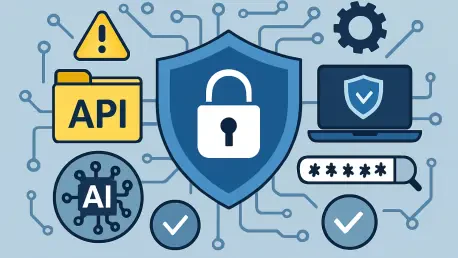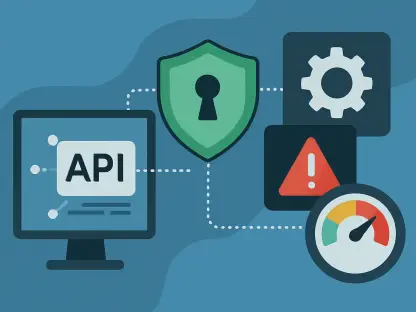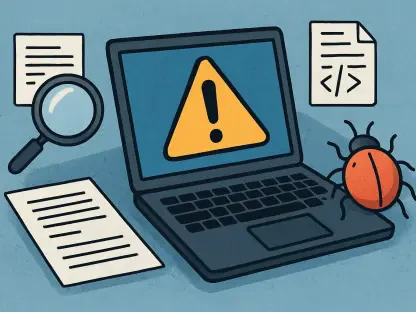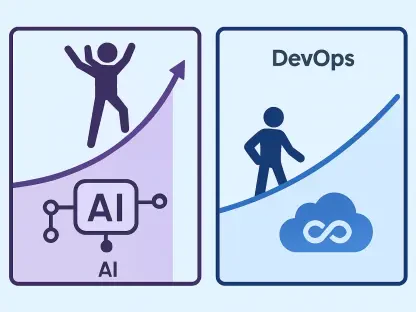In the ever-evolving digital landscape of today, Application Programming Interfaces (APIs) have emerged as the critical connectors that power web applications, microservices, and cloud-based systems, enabling seamless data exchange and functionality across a multitude of platforms. With a staggering 83% of all web traffic now driven by API interactions, their role in driving innovation, supporting mobile applications, and facilitating connectivity in hybrid environments is undeniable. However, this pervasive reliance also significantly broadens the attack surface, positioning APIs as prime targets for cybercriminals seeking to exploit vulnerabilities and access sensitive data. As organizations accelerate their digital transformation journeys, the urgency to protect these vital components has never been greater. Qualys, a prominent name in cybersecurity, has responded to this pressing need with an enhanced Web Application Scanning (WAS) solution, integrating cutting-edge AI-powered API security features to address the growing threats in complex, multi-cloud setups.
The Rising Significance of API Protection
In modern IT architectures, APIs serve as the backbone for a vast array of systems, from mobile applications to intricate hybrid cloud environments, ensuring smooth communication and functionality across diverse platforms. Their importance is evident in how they enable businesses to innovate rapidly, connecting disparate systems and allowing for real-time data sharing that powers everything from e-commerce to financial services. Yet, this widespread adoption comes with a significant downside: each API endpoint represents a potential vulnerability that malicious actors can exploit to gain unauthorized access or compromise sensitive information. The sheer volume of API-driven interactions means that a single unsecured endpoint could jeopardize an entire organization’s security posture, leading to data breaches or operational disruptions. As digital ecosystems expand, the need for robust mechanisms to safeguard these interfaces becomes not just a technical priority but a foundational element of maintaining trust and reliability in digital services.
Beyond the technical risks, the regulatory landscape adds another layer of complexity to API security, with stringent data protection laws imposing strict requirements on organizations worldwide. Frameworks like the General Data Protection Regulation (GDPR) in Europe and the California Consumer Privacy Act (CCPA) in the United States mandate rigorous safeguards for personal data, with non-compliance carrying severe financial penalties and reputational damage. For instance, failing to protect API endpoints that handle sensitive customer information could result in fines reaching millions of dollars, alongside the loss of consumer confidence. These regulations underscore that securing APIs is not merely about preventing cyber threats but also about fulfilling legal obligations that are critical to business operations. Organizations must navigate this dual challenge of technical protection and regulatory adherence, ensuring that their API security strategies align with global standards while maintaining the agility needed to compete in a fast-paced digital market.
Hurdles in Securing API Ecosystems
Protecting APIs presents a formidable challenge for enterprises, particularly as the scale and complexity of digital environments continue to grow, with many organizations managing hundreds of APIs across hybrid and multi-cloud setups. One of the primary obstacles is achieving complete visibility—discovering and cataloging every API in use is often an uphill battle, especially when these interfaces span disparate systems and third-party integrations. Without a comprehensive inventory, blind spots emerge, leaving unmonitored endpoints vulnerable to exploitation by attackers who thrive on overlooked weaknesses. This lack of visibility is compounded by the dynamic nature of modern IT infrastructures, where APIs are frequently deployed or modified, making static security measures obsolete. Enterprises must contend with the reality that failing to track all API activity can result in undetected threats, undermining even the most well-intentioned security efforts and exposing critical systems to risk.
Another significant hurdle lies in balancing robust security with operational efficiency, as organizations strive to protect APIs without compromising the performance that users and applications depend on. Detecting real-time threats and vulnerabilities requires sophisticated tools that can keep pace with evolving attack methods, yet many traditional security approaches fall short, often relying on fragmented solutions that create gaps in coverage. Standards like the OpenAPI Specification (OAS) provide a framework for consistency, but ensuring compliance while managing high-speed development cycles adds further complexity. Additionally, the reliance on disparate tools leads to an overload of alerts, causing fatigue among security teams who struggle to prioritize genuine risks amid the noise. This fragmentation not only hampers effective threat response but also slows down development processes, creating friction between security and innovation goals that organizations must resolve to maintain a competitive edge.
A Breakthrough with AI-Enhanced Security
Qualys has introduced a transformative approach to API protection with its upgraded Web Application Scanning (WAS) solution, harnessing the power of artificial intelligence to tackle the multifaceted challenges of securing digital interfaces. This innovative platform offers comprehensive API discovery and inventory management, ensuring that organizations can identify and monitor all endpoints across their complex environments, from on-premises systems to multi-cloud architectures. By leveraging AI and deep learning technologies, the solution achieves an impressive 96% detection rate for vulnerabilities while reducing scan times by 80%, delivering both accuracy and efficiency. This capability allows security teams to maintain a clear, up-to-date view of their API landscape without the delays that often accompany traditional scanning methods, enabling faster response times to potential threats and minimizing the window of exposure for critical systems.
Further distinguishing this solution are its targeted features, such as over 200 prebuilt signatures designed to address the OWASP API Top 10 risks, a widely recognized benchmark for API vulnerabilities. The platform also facilitates compliance monitoring for critical regulations like GDPR and PCI-DSS, helping organizations avoid costly penalties while maintaining data integrity. Central to its effectiveness is the proprietary TruRisk™ scoring system, which prioritizes risks based on severity and context, empowering teams to focus on the most pressing issues rather than sifting through endless alerts. This intelligent prioritization reduces the burden on security personnel, streamlining workflows and enhancing overall protection. By integrating seamlessly with existing systems, the solution ensures that API security becomes a cohesive part of the broader cybersecurity strategy, addressing both immediate threats and long-term compliance needs with precision.
Bridging Development and Security with Integration
One of the standout aspects of Qualys’ enhanced WAS solution is its ability to integrate effortlessly with Continuous Integration/Continuous Deployment (CI/CD) pipelines and IT ticketing systems, fostering a unified approach to API security. This integration supports the shift-left philosophy, embedding security testing early in the development lifecycle to identify and remediate vulnerabilities before they reach production environments. By catching issues at the source, organizations can avoid the costly and time-intensive process of addressing flaws after deployment, ensuring that APIs are secure from the outset. This proactive stance not only enhances the quality of applications but also aligns security practices with the rapid pace of modern development, allowing teams to innovate without the constant fear of introducing exploitable weaknesses into their systems.
Equally important is the support for shift-right practices, which focus on monitoring and protecting APIs in live, production environments where real-world threats often emerge. The solution provides continuous oversight, detecting anomalies and runtime issues that might evade pre-deployment scans, thus ensuring that APIs remain secure even as usage patterns and attack vectors evolve. This dual approach—combining early intervention with ongoing vigilance—creates a holistic defense strategy that addresses the full spectrum of API risks. By bridging the gap between development and operational security, Qualys enables organizations to maintain agility while upholding stringent protection standards, reducing friction between teams and fostering a culture of collaboration. This balanced methodology represents a forward-thinking response to the dynamic challenges of securing APIs in today’s digital ecosystem.
Paving the Way for Robust API Defenses
Reflecting on the strides made in API security, it’s clear that Qualys has taken a significant step forward with the introduction of its AI-powered Web Application Scanning solution, addressing the critical vulnerabilities that have long plagued digital interfaces. The integration of advanced technologies like AI and deep learning marks a turning point, offering unprecedented detection rates and efficiency that empower organizations to stay ahead of cyber threats. This initiative not only tackles the immediate challenges of visibility and compliance but also sets a new standard for how security can be woven into both development and production phases through shift-left and shift-right practices. Looking ahead, the focus should shift toward adopting such integrated platforms as a core component of cybersecurity strategies, ensuring that API protection evolves alongside emerging threats. Organizations are encouraged to prioritize continuous monitoring, invest in tools that unify fragmented approaches, and foster collaboration between security and development teams to build resilient digital environments for the future.









